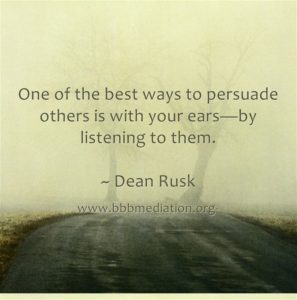Persuade by Listening
I am a fan of the Heath brothers, previously alluding to their books (Made to Stick, Switch & Moments) in earlier posts: https://www.tildensst.com/2015/04/28/review-switch-how-to-change-things-when-change-is-hard/ and https://www.tildensst.com/2020/01/15/why-employee-of-the-month-programs-come-up-short/
Their gift is applying rigorously researched concepts and writing about them in a story-telling and easy to read narrative. One client summed up this way, “I can’t get through Daniel Kahneman and Thinking Fast & Slow1. But I could digest Moments on a plane.”
They also provide useful mnemonic reminders2 like SUCCES (Simple, Unexpected, Concrete, Credible, Emotional & Story) from Made to Stick. Who has forgotten the grade school mnemonic HOMES to remember the great lakes?
Chip & Dan’s fourth book is Decisive, How to Make Better Choices in Life & Work (2013). What I’d like to focus on is their treatment of the essential communication skill of listening. While not academic nor scientific in any fashion, we have consistently found that effective listening is what sets apart high performers from typical ones.
What is it that top performing salespeople do? Listen.
What is it that top performing negotiators do? Listen.
What is that top performing leaders do? Listen.
Yet, how does your audience know you are listening?
The Heaths review a concept called “procedural justice” (p. 242 – 243) which emphasizes the importance of, not just outcome, but process. Recently, I lost an administrative law case I argued on behalf of my now deceased mother. She was in a skilled nursing facility at the time and her doctors, a family member who is a lawyer, and I believed she had been denied Medicare funds due her by the facility.
I felt for the first time in the process that the judge listened to me. She paraphrased what I had said and acknowledged the common sense of my argument. She then pointed-out the legal flaws in my case. When she explained her ruling, which was contrary to my wishes, I accepted it because I felt I had been heard. In a term, the judge provided “procedural justice”.
The Heaths describe a technique we have been teaching and coaching for many years: summarizing. To prove that you have been listening, not just planning your response, summarize for the other party what he or she has said.
Robert Mnookin (P. 244), a mediator in high stakes cases like Sony suing Apple, offers this on how he summarizes:
“I state back the other side’s position better than they could state it. Then they can relax because they feel they have been heard.”
This is what the administrative law judge did for me. I felt heard, relaxed and accepted her judgment.
Next time you are in an important conversation where you are seeking to persuade, try summarizing what the other party is saying. You cannot do it without actively trying to understand the other party. It will provide “procedural justice” and prove you have been listening.
1 I agree that Thinking Fast & Slow is heavy going. It is still on my list of top five must reads.
2 The mnemonic for Decisive is WRAP: Widen Options, Reality Test, Attain Emotional Distance and Prepare to be Wrong.


Comments
Persuade by Listening — No Comments
HTML tags allowed in your comment: <a href="" title=""> <abbr title=""> <acronym title=""> <b> <blockquote cite=""> <cite> <code> <del datetime=""> <em> <i> <q cite=""> <s> <strike> <strong>